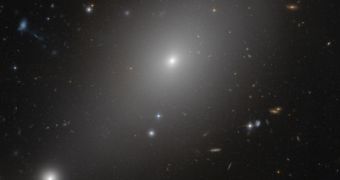Astronomers observed a long time ago the fact that galaxies like to “hang out” in groups. They may be brought closer together by the streams of dark matter they are navigating, or some may have simply drawn each other via gravitational forces, but the point is that they appear to be a “social” bunch. However, studies have revealed the existence of galaxies that break this patterns. These space structures are loners, with no company to keep, and experts have many times wondered why this happens. Now, a new study gives scientists a clue as to the possible answer.
Using a recent image collected by the NASA/ESA Hubble Space Telescope, a group of investigators was able to determine why these galaxies appear to be on their own. “The case of the missing neighboring galaxies” has fascinated many, but the gruesome truth may not be so appealing. Analysis revealed that these loners might be all by themselves because they cannibalized on everything else around them. This is not a rare occurrence, given that most massive galaxies – including our own Milky Way – do this regularly. Dwarf galaxies are easy preys for their massive neighbors, which gobble them up every chance they get, experts at the European Space Agency (ESA) report.
The new photo is centered on the large, bright, elliptical galaxy ESO 306-17, which is located some 500,00 million light-years away, in the southern sky. It belongs to a class of space objects called fossil group, named thusly because of their lonely nature. Though the picture shows numerous galaxies around ESO 306-17, the other bodies are most likely closer or farther than the observations target. Detailed images collected by the ESA XMM-Newton mission, and the NASA Chandra X-ray Observatory, show that the elliptical galaxy lies abandoned in a sea of hot gas. Astrophysicists also believe that it may be surrounded by an equally-large halo of dark matter.
“When zooming in closely on ESO 306-17, faint clusters of stars can be seen through the bright shine of the galaxy's large halo. These are globular clusters: tightly bound groups of stars that can often fend off cannibalism from larger, bullying galaxies. Studying these surrounding clusters will prove helpful to astronomers in their pursuit to put the pieces of ESO 306-17's history together. Researchers are also using this image to search for nearby ultra-compact dwarf galaxies. These are mini versions of dwarf galaxies that have been left with only their core after interaction with larger, more powerful galaxies. Most ultra-compact dwarfs discovered to date are near giant elliptical galaxies in large clusters of galaxies, so it will be interesting to see if researchers find similar objects in fossil groups,” the ESA group writes in a press release.

 14 DAY TRIAL //
14 DAY TRIAL //